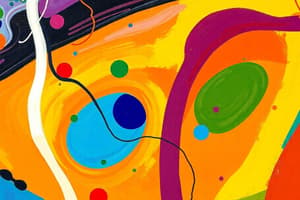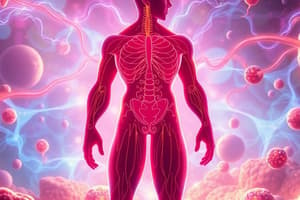Podcast
Questions and Answers
What is produced from one pyruvic molecule during each turn of the cycle?
What is produced from one pyruvic molecule during each turn of the cycle?
- 2 molecules of carbon dioxide
- 4 molecules of carbon dioxide
- 3 molecules of carbon dioxide (correct)
- 5 molecules of carbon dioxide
What is the byproduct of the reaction that forms ATP during the Electron Transport Chain?
What is the byproduct of the reaction that forms ATP during the Electron Transport Chain?
- Oxygen molecules
- Water molecules (correct)
- Carbon dioxide molecules
- Hydrogen ions
Where does the Electron Transport Chain occur?
Where does the Electron Transport Chain occur?
- In the mitochondrial matrix
- In the mitochondria's outer membrane
- In the cytosol
- In the cristae of the mitochondria (correct)
What is the role of NADH and FADH2 in the Electron Transport Chain?
What is the role of NADH and FADH2 in the Electron Transport Chain?
What is the function of ATP synthase?
What is the function of ATP synthase?
What is the energy source for generating ATP during the Electron Transport Chain?
What is the energy source for generating ATP during the Electron Transport Chain?
What is the byproduct of the reaction that forms carbon dioxide during the Krebs cycle?
What is the byproduct of the reaction that forms carbon dioxide during the Krebs cycle?
What is the outcome of the Electron Transport Chain process?
What is the outcome of the Electron Transport Chain process?
What is the product of glycolysis that is then oxidized to form acetyl-CoA?
What is the product of glycolysis that is then oxidized to form acetyl-CoA?
Where does the glycolysis process take place?
Where does the glycolysis process take place?
What is the primary function of glycogen synthase in glycogenesis?
What is the primary function of glycogen synthase in glycogenesis?
What is the net gain of ATP per molecule of glucose in glycolysis?
What is the net gain of ATP per molecule of glucose in glycolysis?
What is the byproduct of pyruvate oxidation that is used in the citric acid cycle?
What is the byproduct of pyruvate oxidation that is used in the citric acid cycle?
What is the product of the reaction between glucose-1-phosphate and uridine triphosphate (UTP) in glycogenesis?
What is the product of the reaction between glucose-1-phosphate and uridine triphosphate (UTP) in glycogenesis?
What is the formula for the reaction of pyruvate oxidation?
What is the formula for the reaction of pyruvate oxidation?
What is the purpose of glycogenolysis?
What is the purpose of glycogenolysis?
What is the first step in glycogenolysis?
What is the first step in glycogenolysis?
Where does pyruvate oxidation take place?
Where does pyruvate oxidation take place?
What is the product of the citric acid cycle that is used in the electron transport chain?
What is the product of the citric acid cycle that is used in the electron transport chain?
What is the byproduct of the reaction between glucose-1-phosphate and UTP in glycogenesis?
What is the byproduct of the reaction between glucose-1-phosphate and UTP in glycogenesis?
What is the primary function of the electron transport chain?
What is the primary function of the electron transport chain?
What is the role of UDP-glucose in glycogenesis?
What is the role of UDP-glucose in glycogenesis?
What is the result of the formation of glycosidic bond in glycogenesis?
What is the result of the formation of glycosidic bond in glycogenesis?
What is the overall outcome of glycogenesis?
What is the overall outcome of glycogenesis?
Study Notes
Glycogenesis: Formation of Glycogen
- Glycogenesis is a four-step process that converts glucose into glycogen.
- Step 1: Isomerization of glucose-6-phosphate to glucose-1-phosphate, catalyzed by phosphoglucomutase.
- Glucose + ATP → glucose-6-phosphate → glucose-1-phosphate.
Step 2: Formation of UDP-Glucose
- Reaction of glucose-1-phosphate with uridine triphosphate (UTP) to form UDP-glucose.
- Glucose-1-phosphate + UTP → UDP-glucose + pyrophosphate (PP).
Step 3: Formation of Glycosidic Bond
- Growing the glycogen chain by attaching UDP-glucose to an existing glycogen chain, releasing UDP.
- This reaction is catalyzed by glycogen synthase, the key regulatory enzyme of glycogenesis.
Step 4: Branching of Glycogen
- Glycogen chains grow as glycogen synthase adds glucose residues, producing additional branches.
Glycogenolysis: Breakdown of Glycogen
- Glycogenolysis is a process that breaks down glycogen to release energy in between meals or after glucose depletion.
- Step 1: Breakdown of glycogen into glucose-1-phosphate by phosphorolysis.
Cellular Respiration
- Cellular respiration is the process of generating energy for the cell through the breakdown of glucose.
Glycolysis
- Glycolysis is the first step of cellular respiration, converting glucose into pyruvate.
- One molecule of glucose is broken down to form two molecules of pyruvic acid.
- Occurs in the cytoplasm of the cell.
- Produces a net gain of 2 ATP per molecule of glucose.
- Glucose + 2ADP + 2Pi + 2 NAD + → 2 pyruvate + 2ATP + 2 NADH.
Pyruvate Oxidation
- Pyruvate oxidation is the conversion of pyruvate into acetyl-CoA.
- Occurs in the mitochondrial matrix.
- 2 pyruvate + 2 NAD+ + 2 CoA → 2 acetyl-CoA + 2 NADH + 2H+ + 2CO2.
Krebs Cycle (Citric Acid Cycle)
- The Krebs cycle is the second stage of cellular respiration, converting acetyl-CoA into carbon dioxide.
- Occurs in the mitochondria.
- For each turn of the cycle, 3 molecules of carbon dioxide are produced, and 5 pairs of hydrogen atoms are removed.
- Forms (per two molecules of pyruvic acid) carbon dioxide, two ATP molecules, 6 NADH molecules, and 2 FADH2 molecules.
- Oxaloacetate + acetyl-CoA + ADP + Pi + 3 NAD+ + FAD → CoA + ATP + 3NADH + 3H+ + FADH2 + 2CO2 + Oxaloacetate.
Electron Transport Chain (ETC)
- The electron transport chain is the third stage of cellular respiration, generating ATP from the energy released during the transfer of electrons.
- Occurs in the cristae of the mitochondria.
- The electrons in NADH and FADH2 flow through a series of electron transport acceptors, generating ATP.
- Most of the ATP produced during cellular respiration is made during this stage.
- ATP is made by adding inorganic phosphate to ADP.
Studying That Suits You
Use AI to generate personalized quizzes and flashcards to suit your learning preferences.
Description
This quiz covers the two-step process of converting glucose-6-phosphate to glucose-1-phosphate, involving ATP and UTP. It's an essential biochemistry concept for understanding cellular metabolism.




